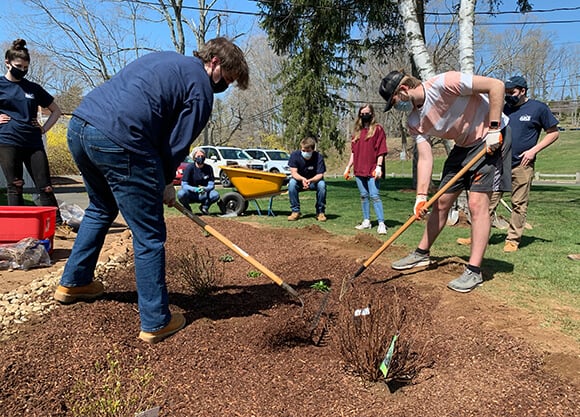
Assistant Professor of Biology
The Lawson lab has two main research areas: (1) pollinator health and nutrition and (2) the evolution of social behavior. Native pollinator diversity is crucial for a healthy and functioning ecosystem and the stability of agricultural production. Outside of honey bees, very little is known about the nutritional requirements of native bee populations. The Lawson lab works to understand questions such as: How does the nutritional landscape shape the native bee community? How does floral resource availability impact foraging habits? How does nutritional availability affect physiology? The main focus of the second project is the evolution of social behavior. One of the major transitions in animal evolution is the shift from solitary to social living. The goal of comparative studies of social evolution is to understand the factors involved in this transition and to answer questions such as: What are the commonalities of social behavior across socially living taxa? What are the ecological/ demographic/ life history predictors of these commonalities?
Education
- PHD, Vanderbilt University
Areas of Expertise
- Pollinator ecology and health
- Social behavior
- Entomology
- Evolution
Organization
- Biological Sciences
Office Location
- Buckman Center BC-145
Mail Drop
- BC-SCI
Experience
Quinnipiac University
Assistant Professor of Biological Sciences
Hamden, CT
2019 - Present
Sacred Heart University
Full-time Lecturer
Fairfield, CT
2018 - 2019
University of New Hampshire
National Science Foundation Postdoctoral Research Fellow
Durham, NH
2014 - 2018
Vanderbilt University
Doctoral Student
Nashville, TN
2009 - 2014
Selected Publications
Peer Reviewed Journal
The invasive acanthocephalan parasite Pachysentis canicola is associated with a declining endemic island fox population on San Miguel Island
Aleuy OA, Woods LW, Padilla BJ, Richardson D, Schamel JT, Baker S, García-Varela M, Hammond C, Lawson SP, Childress JN, Rohr J, Lafferty KD
International Journal of Parasitology (2024)
Conference Presentation
The effect of pollinator garden installation on local pollinator health.
Abdulkadir A, Przestrzelski M, Smart D, Lawson SP
College of Arts and Sciences Student Research Symposium (2024)
Conference Presentation
Investigating the effects of biogenic amines on the dominance hierarchy within the subsocial small carpenter bee, Ceratina calcarata.
Miller R, Lawson SP
College of Arts and Sciences Student Research Symposium (2024)
Conference Presentation
Observing the color preference of native pollinators.
Bacon L, Metzler K and Lawson SP
Eastern Colleges Science Conference (2023)
Conference Presentation
Impact of pollinator gardens on pollinator diversity and populations.
Filandro A, Smart D, and Lawson SP
Eastern Colleges Science Conference (2023)
Conference Presentation
Investigating the life cycle and dominance hierarchy of the subsocial small carpenter bee, Ceratina calcarata
Miller R and Lawson SP
Eastern Colleges Science Conference (2023)
Conference Presentation
Investigating the effects of biogenic amines on the dominance hierarchy within the subsocial small carpenter bee, Ceratina calcarata.
Miller R, Lawson SP
Entomological Society of America conference (2023)
Conference Presentation
Determining the color preference of native pollinators in Connecticut
Neville, J., Lawson, S.
Eastern Colleges Science Conference (2022)
Peer Reviewed Journal
Woodard SH, Federman S, James RR, Danforth BN, Griswold TL, Inouye D, McFrederick QS, Morandin L, Paul DL, Sellers E, Strange JP, Vaughn M, Williams MN, Branstetter GM, Burns C, Cane J, Cariveau AB, Cariveau DP, Childers A, Childers C, Cox-Foster DL, Evans EC, Graham KK, Hackett K, Huntzinger KT, Irwin R, Jha S, Lawson SP, Liang C, López-Uribe MM, Melathopoulos A, Moylett HMC, Otto C, Ponisio LC, Richardson LL, Rose R, Singh R, Steeger T, Wehling W
Woodard SH, Federman S, James RR, Danforth BN, Griswold TL, Inouye D, McFrederick QS, Morandin L, Paul DL, Sellers E, Strange JP, Vaughn M, Williams MN, Branstetter GM, Burns C, Cane J, Cariveau AB, Cariveau DP, Childers A, Childers C, Cox-Foster DL, Evans EC, Graham KK, Hackett K, Huntzinger KT, Irwin R, Jha S, Lawson SP, Liang C, López-Uribe MM, Melathopoulos A, Moylett HMC, Otto C, Ponisio LC, Richardson LL, Rose R, Singh R, Steeger T, Wehling W
Biological Conservation (2020)
Conference Presentation
Pollen composition significantly impacts development and survival of the native small carpenter bee, Ceratina calcarata.
Lawson SP, Rehan SM
Entomological Society of America Conference. (2020)






